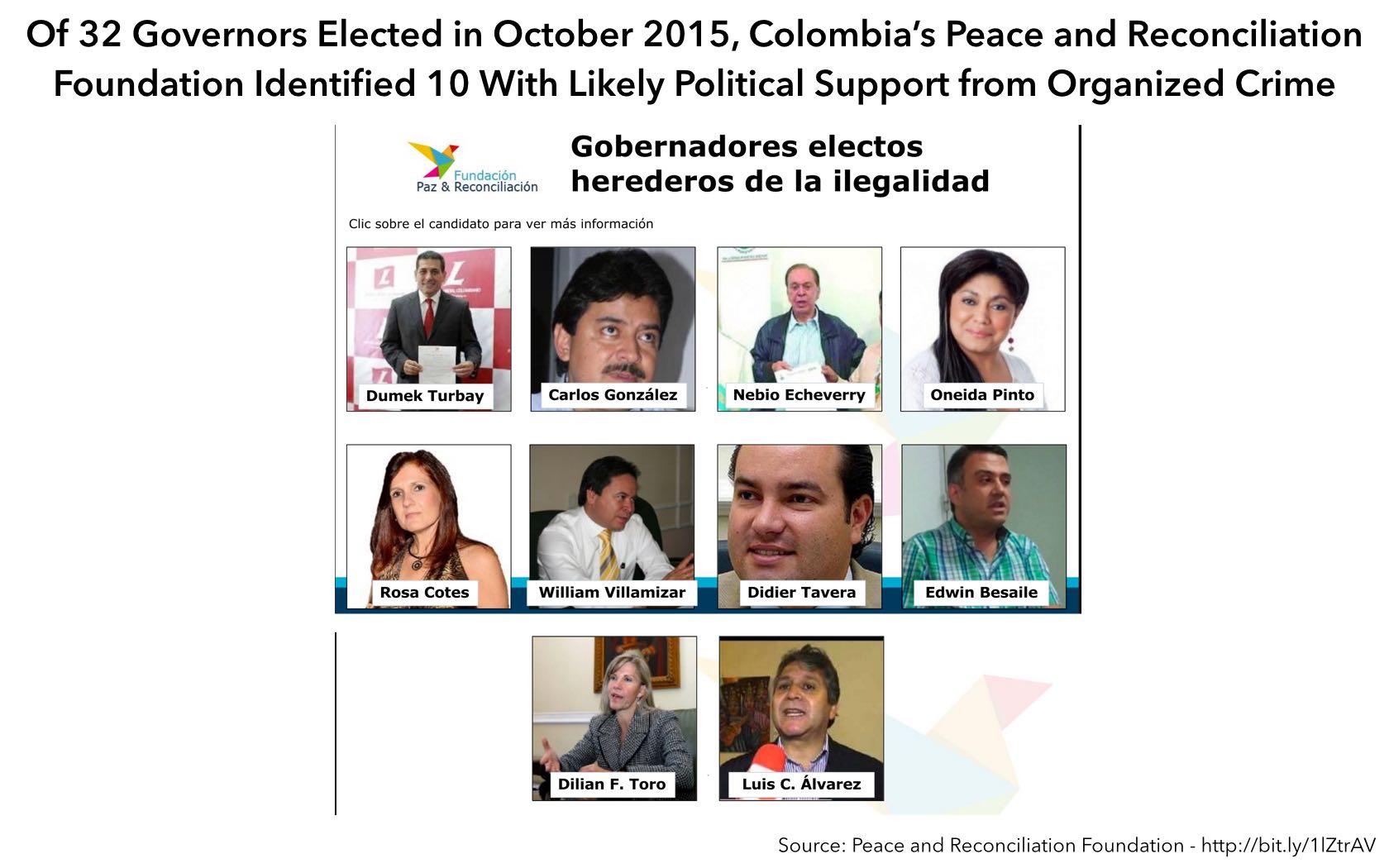Rooting Out Corruption
Perhaps the greatest threat to Colombia’s democracy is the power that organized crime continues to enjoy over much of the political system, judiciary, security forces, and economy, especially at the local level. A legacy of the armed conflict is that significant areas of the country are democracies in form only. Power at the departmental and municipal level is often wielded by criminals, or people with violent criminals’ support. While this phenomenon is all too common in many of Latin America’s most violent countries, it is particularly strong in Colombia.
At times, the criminals in question are the FARC and ELN guerrillas, whose preferred candidates may hold local offices. Studies indicate that this “FARC-politics” phenomenon has generally occurred at the hyper-local level, within municipalities, implicating council members, neighborhood advisory committees, and a few mayors. Very rarely is a governor or national politician found to be a covert backer of a guerrilla organization. The guerrillas’ mission, after all, has been to confront the state violently, not to participate in it.
The more powerful illegal political coalition—what Colombians refer to when they talk about the “mafia” in politics—is a loose nexus of narcotraffickers, large landholders, corrupt politicians, and individual security-force members, whose power is greater outside the principal cities. This is the coalition that created and supported paramilitary groups since the 1980s, and that benefited most from the “reverse land reform” that displaced millions of small landholders during the conflict.
(Text continues after the graphic)

Colombia got its most thorough look at these local politico-criminal elites in the late 2000s and early 2010s, during the so-called “Para-Politics” scandal investigations. Judicial and non-governmental investigators, and demobilizing members of the AUC paramilitaries, revealed that a large segment of Colombia’s political class had made common cause with drug-funded paramilitary groups that had massacred thousands of Colombians, and displaced millions. One of the non-governmental investigators, Claudia López (now a senator), wrote in 2010:
Statistics revealed by the Prosecutor-General’s Office’s Justice and Peace Unit indicate that one-third of Colombia’s mayors, governors, and congresspeople during the last decade may have been promoted by narco-paramilitarism, and that they co-governed with them, and others with the guerrillas. This amount of high dignitaries and public servants under investigation has also made clear that illegal actors weren’t as clandestine or isolated as had been thought. Instead, they had the backing of a large number of “decent” people and an enormous political structure to promote their objectives, at all territorial, political, and institutional levels.
In its last count of national “para-politicians” (2012), the Bogotá think-tank INDEPAZ identified 43 senators and 39 representatives investigated or detained.
Though the “para-politics” investigations reduced the political influence of Colombia’s mafiosi at the national level, it did not eliminate it. In the runup to Colombia’s October 2015 mayoral and gubernatorial elections, independent monitors like Colombia’s Peace and Reconciliation Foundation identified a large number of candidates with ties to organized crime, or with the support of local political machines that, a decade earlier, had allied with paramilitarism. The above graphic, from the Foundation’s website, identifies 10 of the 32 departmental governors elected last October who have likely organized-crime ties.
Implementing a peace accord with the FARC will place Colombia’s national government on a collision course with these local politico-criminal alliances. So will any effort to increase governance and reduce impunity in Colombia’s “regions,” like the struggling land restitution program launched in 2011. These alliances have a recent record of recurring to violence and mass intimidation to block policies that oppose their interests.
But they don’t always have to go that far. The mafia’s corrupting influence also works at the national level, because Bogotá politicians occasionally find them useful. Their “get-out-the-vote” efforts, often through mass vote-buying, can make all the difference in winning a majority in a close presidential or congressional election. Political scientist Edward Gibson, who coined the term “subnational authoritarianism in democratic countries,” could be describing Colombia when he explains national elites’ odd symbiosis with local, organized crime-tied politicians:
Authoritarian provincial political elites, with their abundant supplies of voters and legislators, can be important members of national governing coalitions. Thus, democratically elected central governments may find that the costs of challenging peripheral authoritarians outweigh the benefits because the authoritarian periphery serves the democratic center in tasks vital to national political governance.
In a country the size of Colombia, the peace accords cannot be implemented by “remote control” from a few ministries in Bogotá. Implementation will rely on the labors of governors, mayors, judicial personnel, and civil society at the local level. If those officials are tied to violent organized crime, the peace accords’ commitments are likely to go unfulfilled. Breaking these links will require a well-resourced, well-protected, technologically capable justice system, with a strong presence in regions where organized crime is strong.
 15
15